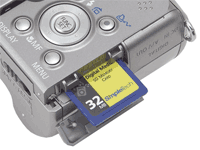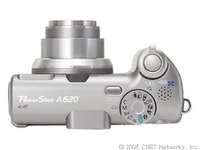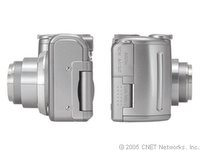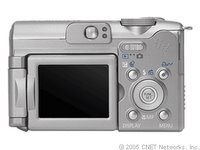
Sliding easily to the head of Canon's A-series line, the 7-megapixel PowerShot A620 (and its 5-megapixel sibling, the PowerShot A610) steps comfortably into the large shoes worn by the wildly popular PowerShot A95. With a 4X optical zoom that spans a useful 35mm-to-140mm (35mm-equivalent) range, the Canon PowerShot A620 keeps up the A95's tradition of packing full manual controls and a solid list of scene modes into an easy-to-use, moderately sized camera that will meet the needs of a broad spectrum of photographers. Given the A620's improved performance, higher-quality movie clips, larger LCD, G-series lens, and high resolution, some current PowerShot A95 users may even want to consider an upgrade.
Design
From the front, other than its battleship-gray body (in contrast with the A95's silver styling), it's unlikely you'll see much difference between the Canon PowerShot A620 and its predecessor. It's about the same size and weight (11.5 with four AA batteries and SD card) and has a nice-size handgrip, which means that those with larger hands will find it more comfortable to hold than the many ultracompact models on the market today.


However, the vari-angle LCD now measures 2 inches, and because of its increased size, Canon has moved some of its buttons. A small mode switch sits horizontally to the upper right of the LCD, so toggling between playback and capture takes little effort. Below, four control buttons surround the four-way controller. One does multiple duties by deleting images during playback, adjusting exposure compensation, and in full manual mode, jumping between aperture and shutter-speed settings. A display button cycles through three LCD options: off, no information, and full information. The Canon PowerShot A620 also has a Menu button and a Print/Share button for transferring images to a computer or a compatible printer.

In the center of the four-way controller is one of the camera's most convenient features: the Function button. It brings up a menu of the most frequently changed settings, including resolution, compression, white balance, ISO, drive mode, effects, flash intensity, and metering. While you're operating any of the controls, the camera feels responsive and the menus are clear, bright, and easy to read.
Regardless of whether you choose program or full-manual mode or a scene mode, the user-friendly Canon PowerShot A620 generally won't trip you up with confusing icons or menu references.
Features

The Canon PowerShot A620 has it all: full manual exposure controls; auto, program, and scene modes for snapshooting; and a high-quality video mode--there's something for every photographer and every shooting situation. You can even choose a shooting mode that fits your mood. After all, some days you might just want to point and shoot; other days, you might feel more enthused about manual controls.
While you won't find as many advanced features as on some more sophisticated cameras, the Canon PowerShot A620 provides enough to keep most control-happy photographers satisfied. They include manual white balance, low sharpening, sepia and black-and-white effects, three metering options, and settings for vivid and neutral color.
We particularly like two features: the camera's Flexizone focusing option and the ability to layer a grid over the LCD to line up horizons and other straight edges. The Flexizone option lets you manually move the focus point so that your off-center subjects come out sharp. Another helpful feature is Safety Shift, which functions in aperture-priority or shutter mode and selects the proper aperture or shutter-speed setting if your choice doesn't quite work out. For instance, if your selected shutter speed requires an aperture wider than the PowerShot A620 can produce, the camera compensates to prevent an underexposed shot. You can also save your settings so that you don't have to dig around the setup menu to prevent the camera from resetting everything when it powers down.

On the easy-to-use side, the camera offers a point-and-shoot automatic mode, as well as a program mode that allows you to adjust pretty much everything except the aperture and shutter speed. Of course, the scene modes make shooting easy by automatically choosing the best settings for a particular type of subject. To use them, you select standard modes such as Portrait and Landscape via the mode dial; a special scene-mode setting then makes other options available via the menu system. These include Kids And Pets, Foliage, Fireworks, Snow, Beach, and even an Underwater setting for use with Canon's underwater housing, which is good to a depth of 130 feet. Other optional accessories include wide, telephoto, and macro add-on lenses as well as a higher-powered flash.
Canon has upped the video ante with this camera: you can now shoot 30fps VGA movies with sound up to 1GB. There's even a fast-frame movie mode that records QVGA movies at 60fps, but it stores only up to 60 seconds per clip.
Performance

The addition of Canon's Digic II processor kicks the Canon PowerShot A620 up a notch or two from the PowerShot A95, but it's still not the fastest camera on the block. That said, it generally performed well in our tests, with a time to first shot of less than 2 seconds and a shot-to-shot time of about 1.8 seconds. Not surprisingly, using the flash slowed things down, and we had to wait about 3 seconds for the flash to recycle.
At about 1.8fps, the Canon PowerShot A620's continuous-shooting speed at high resolution was faster than the A95's; and even after 60 shots, the camera kept on taking pictures. Low-resolution continuous-shooting speed was down only a fraction of a second from the PowerShot A95's, coming in at 2fps. Again, the A620 seemed to set no limit on the number of images it would capture, but we stopped after 50.
The zoom lens was responsive, albeit a little noisy, and the powerful AF illuminator did a good job with low-light autofocus. At 2 inches, the LCD is larger than the A95's, but with all the 2.5-inch LCDs out there, it somehow seems a little puny. It's quite visible, though, and gains up in low light. As always, we made good use of the LCD's rotating capabilities.
Image quality
As expected, the Canon PowerShot A620 provided very, very good image quality. Our test shots were sharply focused, with good detail. Exposures were generally spot-on, with only a few overexposed highlights. Color saturation was accurate but not over the top, so those of you who like supersaturated colors may want to pump them up with the Vivid setting or one of the color-enhancing My Color options.

Automatic white balance appeared to work slightly better than on other Canon models, since indoor images without flash did not look as warm or yellow-toned. On the other hand, some of our outdoor just-before-dusk shots looked a little cooler (bluer) than anticipated when shot on automatic.
We noticed little noise at low ISOs. It was more visible in shadows and at higher ISOs, but we don't think it would spoil even relatively large (8x10) prints. The images also showed less purple fringing than we usually see with Canon consumer cameras, possibly because the PowerShot A620 uses the latest G-series lens.
Ratings
Design: 7
Features: 8
Performance: 7
Image quality: 8

0 comments: